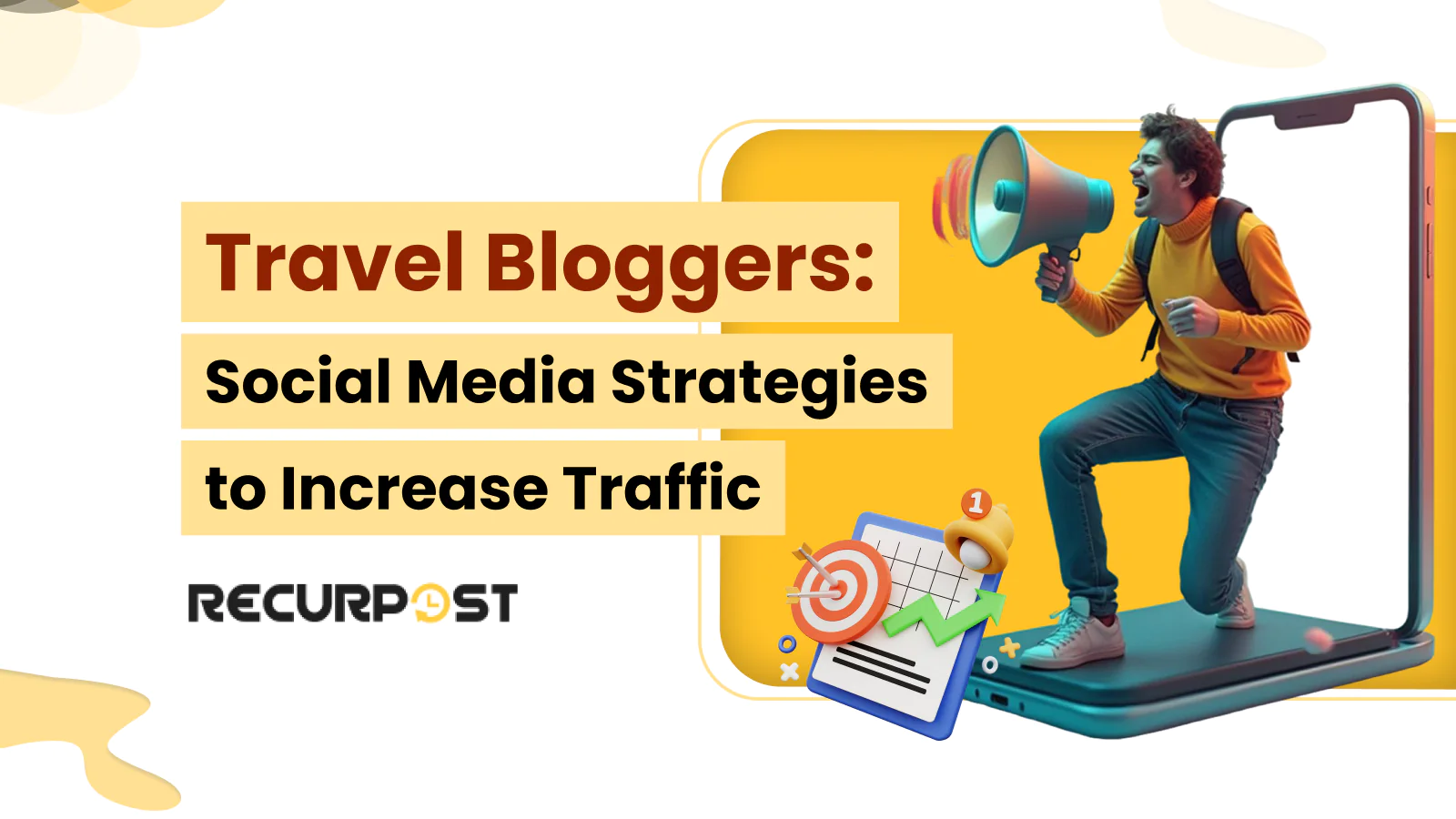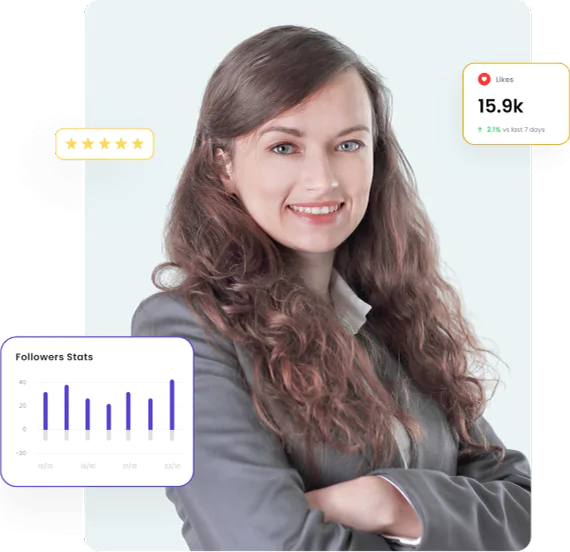Your Travel Blog Needs Social Media to Thrive in 2025
Running a travel blog without social media marketing in 2025 leaves your content nearly invisible. Posts about Tuscany’s hidden gems or backpacking Southeast Asia need social channels to capture readers, boost audience engagement, and attract brand partnerships.
Short-form videos now drive 73% of travel inspiration choices (Statista), making TikTok and Instagram Reels vital for content creation.
Travel bloggers can use digital marketing for travel content by repurposing blog posts into Reels, Pinterest pins, or TikTok short-form videos that expand reach, generate traffic, and support a consistent content repurposing for travel blogs system.
This roadmap provides practical steps, real examples from leading travel bloggers, and methods to grow a profitable brand through social media strategy for travel content creators.
What You’ll Get:
- Platform-specific social media tips
- Proven examples that drive traffic generation and engagement
- Clear paths to monetize your blog with brand collaborations
- Inspiration that attracts travelers to engage with your travel blog
Choosing the Right Social Platforms For a Travel Blog (And How to Win on Each)
Travel bloggers can grow their audience through a social media strategy by avoiding the mistake many make from day one: trying to be everywhere at once. Those who focus on two or three social platforms and dominate those spaces achieve stronger audience engagement and measurable growth compared to spreading thin across seven channels.
Focus on a few social media platforms and dominate those spaces completely.
1. Instagram: Still the Crown Jewel for Travel Blog
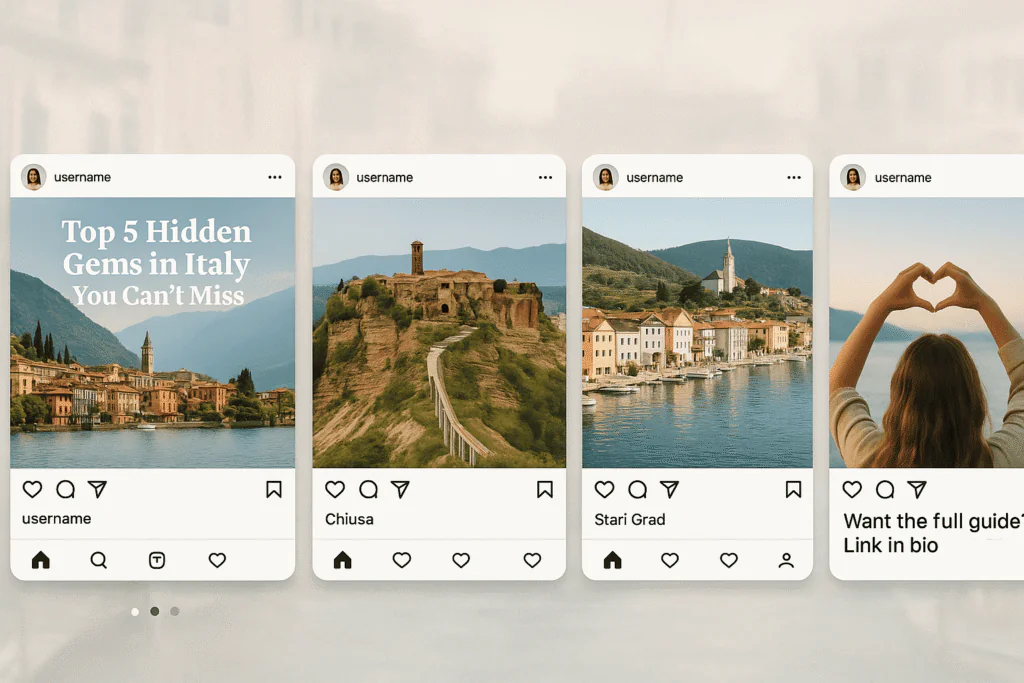
Instagram remains the holy grail for travel bloggers, though the platform has shifted since 2020. Instagram Reels now dominate, while relying only on feed posts limits growth and traffic generation.
The New Instagram Game Plan for Travel Blog
A strong Instagram plan rests on three pillars: stunning visual storytelling, authentic content, and consistent audience engagement. Perfection is less important than authenticity. Travel bloggers now thrive by showing real moments, travel fails, and behind-the-scenes content alongside professional shots. This style builds authentic connections and stronger brands.
Carousel posts are powerful for engagement. They keep people swiping, which Instagram’s algorithm optimization favors. Try the “Before/After” carousel: first slide shows the polished version of a location, the second slide shows the reality when you arrive.
Captions now carry weight. Treat them like mini travel blog posts that share authentic educational travel content, tips, or cultural insights. The fastest-growing accounts write captions that feel like journeys, drawing readers in instead of leaving them as passive viewers.
Reels That Transfer Traffic To Travel Blog
Travel bloggers sometimes prioritize polished visuals over useful storytelling in Instagram Reels. The Reels that consistently pass 100K+ views use hook formulas for travel content and answer clear questions like: “Is Bali worth the hype?” or “What I wish I knew before visiting Iceland.”
Grab attention in the first three seconds with strong visual hooks or a bold question. Deliver real value by mixing educational travel content, inspirational travel content, and honest reviews. This approach builds trust while fueling audience engagement. Instagram’s algorithm optimization favors Reels that hold attention through completion, so structure videos with a clear payoff.
2. TikTok: Where Travel Blog Goes Viral
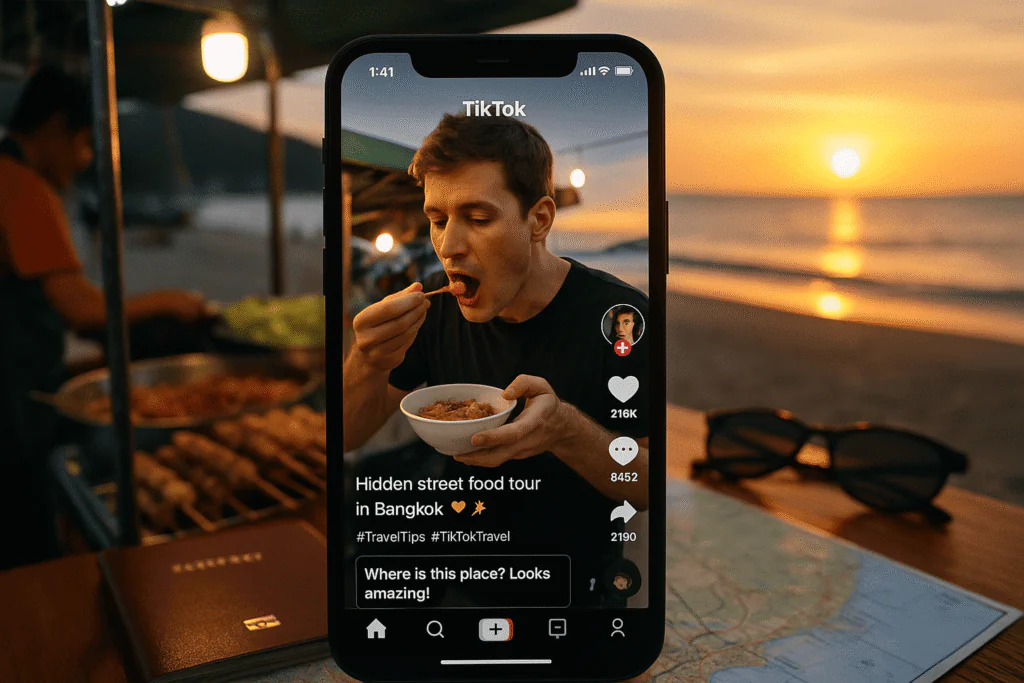
TikTok is no longer just for Gen Z; it has become a powerful travel research hub. The travel industry now uses social media marketing for travel blogs because over 60% of users discover destinations through TikTok. This shift shows how short-form videos influence modern travelers.
Science Direct confirms that authentic, spontaneous TikToks resonate most, making it vital for creators to adopt platform-specific strategies that match audience behavior and expectations.
Mastering TikTok’s Unique Culture
TikTok thrives on authenticity. Unedited clips of street food markets or local bus rides often outperform polished drone videos. The platform rewards spontaneity and genuine storytelling.
Best social media marketing tactics for travel content include using trending sounds strategically. Adapt audio that complements your destination or educational travel content, rather than copying every trend. A destination montage video can pair with a popular song, while TikTok videos offering practical travel tips benefit from recognizable sound clips.
The comment section is an underused audience engagement tool. Replying within the first hour boosts visibility, while turning questions into behind-the-scenes content or new videos builds stronger community trust.
Travel Hooks That Stop the Scroll
Here are five proven hook formulas for travel content:
- The Cost Breakdown: “I spent 3 weeks in Thailand for $800, here’s exactly how…”
- The Mistake Warning: “Don’t make the same mistake I did in Paris…”
- The Hidden Gem: “This place doesn’t even show up on Google Maps…”
- The Reality Check: “Instagram vs. Reality in Santorini…”
- The Local Secret: “A local taxi driver told me about this spot…”
3. Pinterest: Your Traffic-Driving Powerhouse for Travel Blog
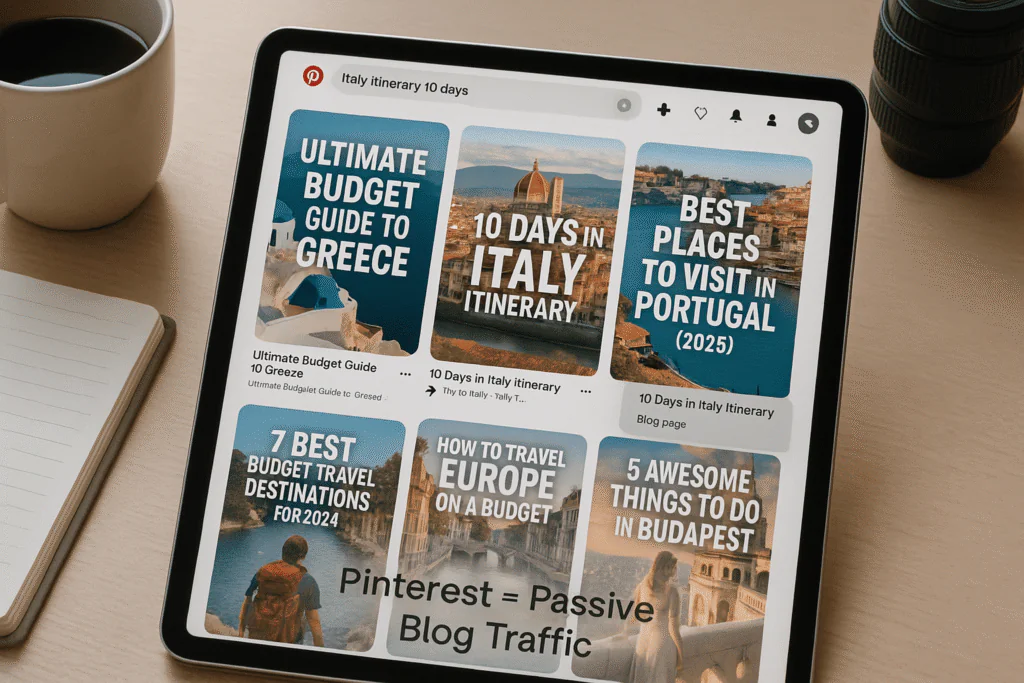
While many creators emphasize video, Pinterest consistently drives more website traffic to a travel blog than any platform except Google. For travel bloggers, it offers a long-term content repurposing method for travel blogs that supports steady traffic growth.
Pinterest SEO That Works For Travel Pin
Pinterest acts more like a search engine than a typical social platform. Pin descriptions should include precise keywords such as “budget travel tips Europe” instead of vague phrases. Strong Pinterest SEO aligns with a broader digital marketing plan for the travel content plan.
Vertical images remain the most effective, especially when paired with visual content (photography) and clear text overlays that share your value in under two seconds.
Seasonal planning is essential. Upload summer Europe guides as early as February because Pinterest users plan months ahead. This early publishing supports content calendar structure and future engagement.
Must Know– Pinterest Pin Dimensions For Effective Content
Driving traffic to your best travel blog
Use Pinterest to repurpose a single blog post into multiple targeted pins. For example, one “10 Days in Japan” post could create pins about itineraries, food guides, cultural insights, and packing lists, reaching multiple search intents. This content multiplication system maximizes reach from one piece of content.
Rich Pins are non-negotiable. They automatically pull metadata from your blog, building credibility and increasing click-through rate. A 30-minute setup can boost both engagement and visibility.
4. YouTube Shorts: Balancing Long and Short-Form Content
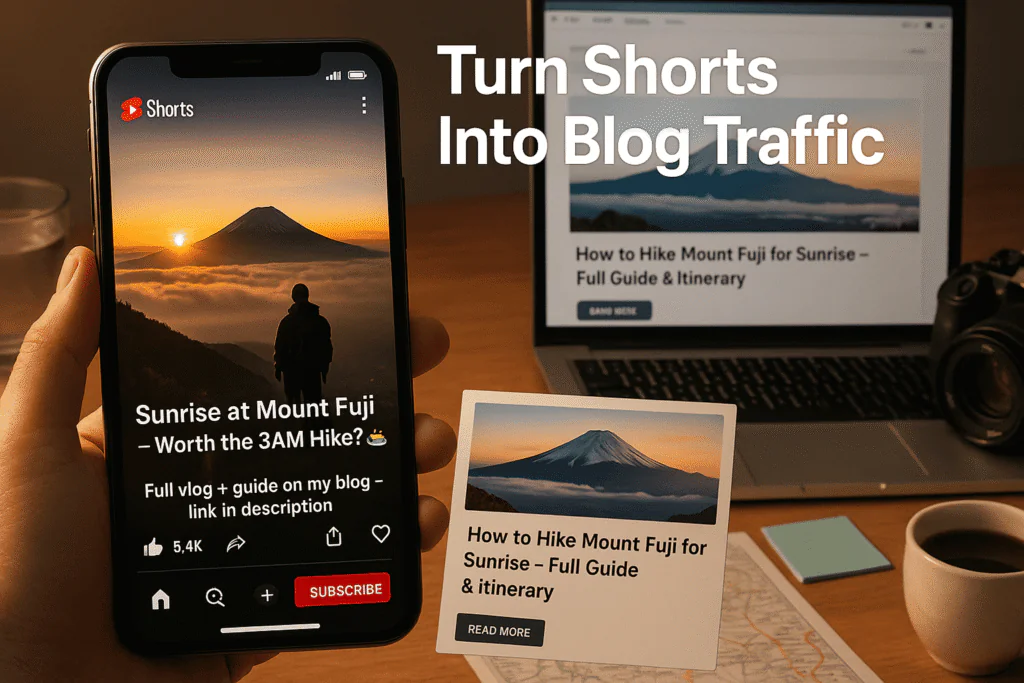
YouTube now competes directly with TikTok by prioritizing YouTube Shorts. Travel bloggers gain an edge by using Shorts to funnel traffic into long-form vlogs, building both audience engagement and website traffic.
The YouTube Shorts Strategy For Travel Shorts
Think of YouTube Shorts as trailers for your main video. A 30-second Bangkok street food clip should close with: “Watch the full food tour on my channel.” This aligns with a platform-specific adaptation mindset.
Short-form videos on YouTube perform best when they’re either useful or entertaining. Time-lapses, educational travel content, or “day and night in my life” segments are consistent performers. The secret is producing videos that feel natural to the Shorts format rather than cut-downs from longer content.
Platform-by-Platform Algorithm Decoder (2025 Edition)
Understanding what each platform’s algorithm values can determine whether your travel blog achieves traffic generation or stays unseen. Here’s what works in 2025:
| Platform | Primary Ranking Factor | Content Format Priority | Best Posting Time | Engagement Sweet Spot |
| Engagement rate within the first hour | Reels > Carousels > Stories | 6-9 AM, 7-9 PM local time | 30+ comments, high saves | |
| TikTok | Completion rate + shares | Native vertical video | 6-10 AM, 7-9 PM EST | High completion rate, comments |
| Click-through rate + saves | Vertical images with text | 8-11 PM, weekends | Saves and clicks on the blog | |
| YouTube | Watch time + engagement | Shorts + long-form balance | 2-4 PM, 8-10 PM | High retention, comments |
Success comes from creating content that naturally aligns with algorithm rewards rather than attempting to game them. Content that generates genuine engagement receives algorithmic promotion.
Creating a Scroll-Stopping Travel Blog Content Strategy
Even with stunning visuals, many travel bloggers struggle to grow beyond 5K followers without a clear social media strategy. The problem isn’t quality; it’s lack of consistent planning that blocks traffic generation and audience growth for travel blogs.
Consistency, intentional posting, and platform-specific strategies convert followers into readers, and readers into loyal fans. Successful creators treat their travel blog like a media business, using a content calendar structure and steady posting frequency and timing to boost visibility.
These bloggers map content themes, repurpose posts with a content multiplication system, and publish material that serves clear audience demographics and engagement needs.
The 5-Part Content Mix Formula For Travel Blogging
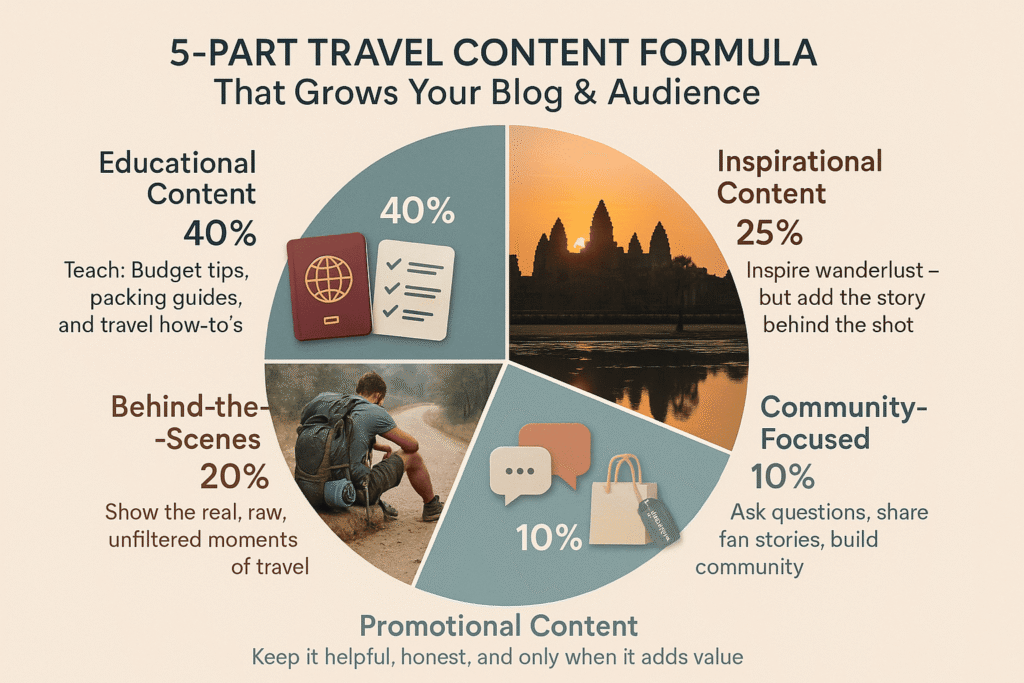
The backbone of a strong social media marketing strategy for travel blogs is the 5-part content mix formula that top creators follow to grow and monetize.
This framework balances educational travel content (40%), inspirational travel content (25%), behind-the-scenes content (20%), community-focused content (10%), and promotional content (5%) to build trust before monetization.
Instead of random posting, this structured content strategy ensures steady audience engagement and sustainable social media success.
Educational Content (40%)
This is the backbone of a travel blog, content that teaches real value. Examples include budget breakdowns, packing tutorials, cultural etiquette guides, or educational travel content like “how-to” videos for destinations.
This type of content performs well across multiple platforms, since users actively search for practical resources. A guide such as “Complete Guide to Solo Female Travel in Morocco” not only drives traffic generation but also boosts long-term engagement metrics months or even years after posting. For more content inspiration, check out 75 Blog Post Ideas To Attract Your Audience in 2025 for practical and creative topics to jumpstart your travel blogging strategy.
Inspirational Content (25%)
Inspirational travel content thrives on stunning visual storytelling that motivates bookings. Sunrise over Angkor Wat, northern lights in Iceland, or Maldivian beaches instantly spark wanderlust.
But here’s the secret: even inspirational content must add context. Go beyond the photo, share the story behind it. What time did you wake up for that sunrise? How many attempts did it take to capture that perfect shot? These authentic storytelling details fuel stronger audience engagement than visuals alone.
Behind-the-Scenes Content (20%)
Audiences crave authenticity in travel content. Sharing behind-the-scenes content, missed flights, food mishaps, or getting lost, creates relatability and fuels audience engagement.
This style of content supports authentic storytelling, reminding followers there’s a real person behind the blog, not just polished images. These moments often perform better than staged visuals, strengthening trust and long-term engagement metrics.
Community-Focused Content (10%)
Community-focused content includes questions, polls, user-generated content, and follower travel experiences. This format strengthens community building and drives engagement metrics that platform algorithms reward.
The strongest community content makes your target audience feel heard and valued. Feature follower travel photos, answer questions in dedicated posts, or shape new content ideas around their suggestions. These steps encourage consistent social media success.
Promotional Content (5%)
Yes, keep this to just 5%. This includes sponsored posts, affiliate marketing, digital offers, or content that sells your custom services. The percentage stays low because trust and authentic value must come before sales.
When creating promotional content, make it genuinely useful. A sponsored hotel review should be honest and detailed, just like organic posts. Your affiliate marketing recommendations should highlight products you actually use. This transparency builds stronger brand partnerships and leads to long-term monetization opportunities for your travel blog.
Must Learn– Affective content creation strategy for 2025
Visual Aesthetics & Captions That Work For Travel Blog
Your visual content (photography) style is your brand signature; it’s how people recognize you in a crowded feed. Consistency doesn’t mean one filter on every photo; it means developing a cohesive look that reflects your travel philosophy.
Balanced visual storytelling boosts both credibility and brand visibility, making your travel blog more appealing to readers and potential brand collaborations.
Developing Your Visual Voice
Some creators prefer bright, saturated colors that radiate adventure, while others lean into cinematic tones that convey mystery and depth. Both work, but your choice should align with your target audience and the travel experiences you promote.
Luxury travel content often attracts audiences who prefer clean, minimalist visuals with white space, while budget backpacking thrives with raw, authentic content and professional photography that reflects cultural realities. This distinction supports stronger audience engagement and niche positioning.
Caption Strategies That Drive Engagement

Your captions are where visual storytelling meets words. They transform a simple image into a teaching moment, a conversation starter, or an emotional bond with your target audience.
The strongest captions use proven hook formulas for travel content: start with a bold opening, add story, share value, and end with a call-to-action. This structure sparks audience engagement and encourages conversation.
Long-form captions (200–300 words) work best for travel creators. Use them for educational travel content, behind-the-scenes insights, or cultural context. Followers value meaningful tips and authentic details, not just pretty pictures. This approach fuels social media success and steady engagement metrics.
Must Use- Our AI-generated caption generator for your travel content
AI Social Media Posts Generator: Create Content with RecurPost
Create engaging social media posts with our AI-powered generator. Save time and boost your content strategy with automated posts for all platforms in seconds.
Visual Hook Frameworks for Reels & TikTok
Short-form videos live or die in the first three seconds. A strong visual hook determines whether viewers stay or scroll. Here are five proven hook formulas for travel content that boost audience engagement and align with algorithm optimization:
The Contradiction Hook
Challenge assumptions about a destination. “Everyone says Paris is expensive, but I spent 5 days there for under $300…” grabs attention through surprise.
The Mistake Hook
People are drawn to failures and lessons. “I made a huge mistake booking this ‘luxury’ resort in Bali…” works because it shares practical advice while sparking curiosity.
The Secret Hook
Offer insider tips most travelers miss. “This hidden beach in Thailand has no tourists because most people can’t find it…” creates exclusivity and positions you as a trusted source of authentic content.
The Transformation Hook
Show before-and-after journeys. “I was terrified of solo travel until this happened in Nepal…” highlights inspirational travel content with personal growth value.
The Numbers Hook
Concrete data builds credibility. “I visited 15 countries for $3,000, here’s exactly how…” works because it provides measurable insights and drives social media success.
Must Learn– How to create a visually appealing YouTube short
Performance Metrics That Matter
Tracking engagement metrics helps creators see which hooks connect best with their target audience and support overall social media success:
- 3-second retention rate: Viewers who watch past the first three seconds.
- Average watch time: How long audiences stay with your short-form videos.
- Completion rate: Percentage who watch your entire video, a core factor in platform algorithms.
- Save rate: How often users save your content for future reference, a sign of authentic content providing value.
- Share rate: Frequency your posts get shared, driving traffic generation and cross-platform reach.
Time-Saving Tools & Content Planning Workflow
Content creation can consume 40+ hours weekly without systems. Top travel bloggers streamline with content batching, automation, and smart tools. They follow a business-like process that saves time while supporting consistent content creation across multiple platforms.
Using scheduling tools, design tools (Canva), and video editing tools allows creators to scale production while maintaining quality. Paired with a strong content calendar structure, these workflows fuel better posting frequency and timing and improve overall social media marketing results.
Content Calendar That Works
Generic calendars that say “post 3 times per week” won’t cut it. A strong content calendar structure should reflect your travel schedule, seasonal trends, and platform-specific strategies. This ensures your posting frequency and timing align with audience habits for maximum engagement metrics and consistent social media success.
The Travel Blogger’s Content Calendar Structure
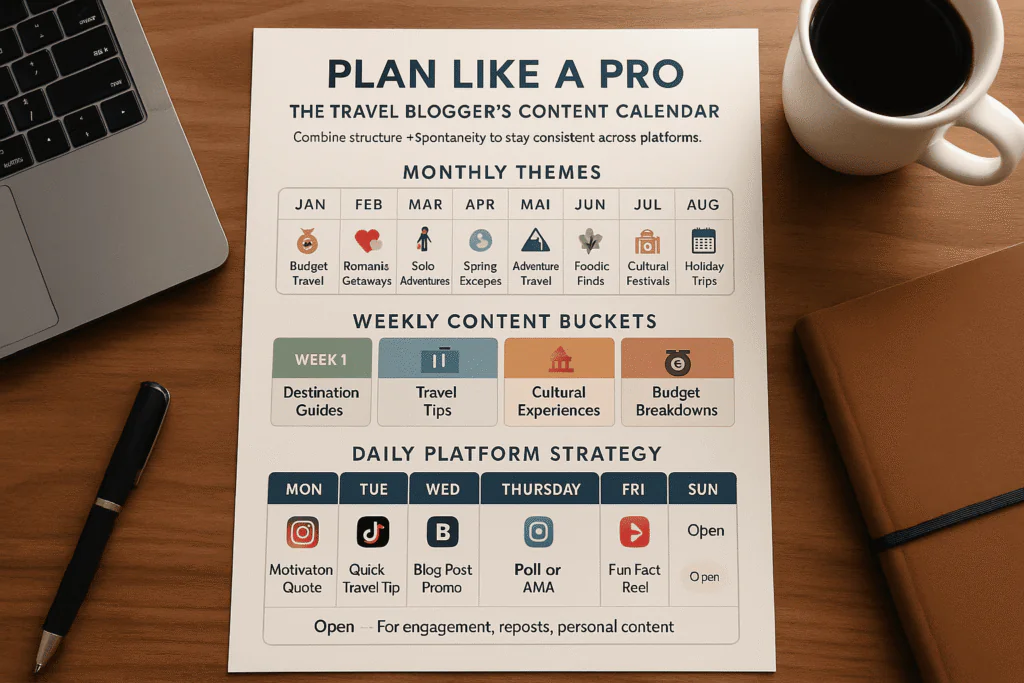
Monthly Themes
Assign each month a broad theme tied to your content strategy. Example: January = budget travel, February = romantic destinations, March = solo adventures. This supports organized planning and better audience engagement.
Weekly Content Buckets
Rotate weekly categories to cover multiple needs: week one = destination guides, week two = travel tips, week three = cultural insights, week four = budget breakdowns. This content repurposing model keeps ideas fresh while fueling steady traffic generation.
Daily Platform Strategy
Plan daily posts by platform: Monday = Instagram motivational posts, Tuesday = TikTok videos, Wednesday = travel blog promotion, Thursday = community-focused content, Friday = fun travel facts. This ensures consistent cross-platform promotion.
Planning Around Your Travel Schedule
A common mistake is trying to create content on the go. Instead, batch during sprints. Dedicate 2–3 days to batch content creation, then document and engage while traveling. This balances efficiency with authentic storytelling.
Tool Comparison: Free vs Paid Options
| Function | Free Option | Paid Option | Winner For | Monthly Cost |
| Design | Canva Free | Canva Pro | Beginners: Free, Pros: Paid | $0 / $15 |
| Scheduling | Later Free | Buffer | Volume posting: Buffer | $0 / $99 |
| Analytics | Native platform tools | Sprout Social | Deep analysis: Paid | $0 / $199 |
| Video Editing | CapCut | Adobe Premiere | Quick edits: Free, Pro: Paid | $0 / $23 |
| Stock Photos | Unsplash | Shutterstock | Quality needs: Paid | $0 / $29 |
| Content Recycling | RecurPost Free | RecurPost | Evergreen scheduling & reuse | $0 / $25 |
The Smart Investment Strategy For Travel Blog
Start with free tools and upgrade based on real needs. Skip premium analytics tools until you’re consistently producing content creation at scale. Avoid costly design software if design tools (Canva) meet your standards.
For most travel bloggers, the first smart purchase is scheduling tools. Once consistent posting frequency and timing are achieved across multiple platforms, automation prevents burnout and supports long-term social media marketing growth.
Repurpose Content Across Channels To Promote Travel Blog
One piece of content can fuel cross-platform promotion if adapted correctly. This isn’t copy-paste, it’s a platform-specific adaptation that tailors your travel blog post for different audiences and formats.
The Content Multiplication System
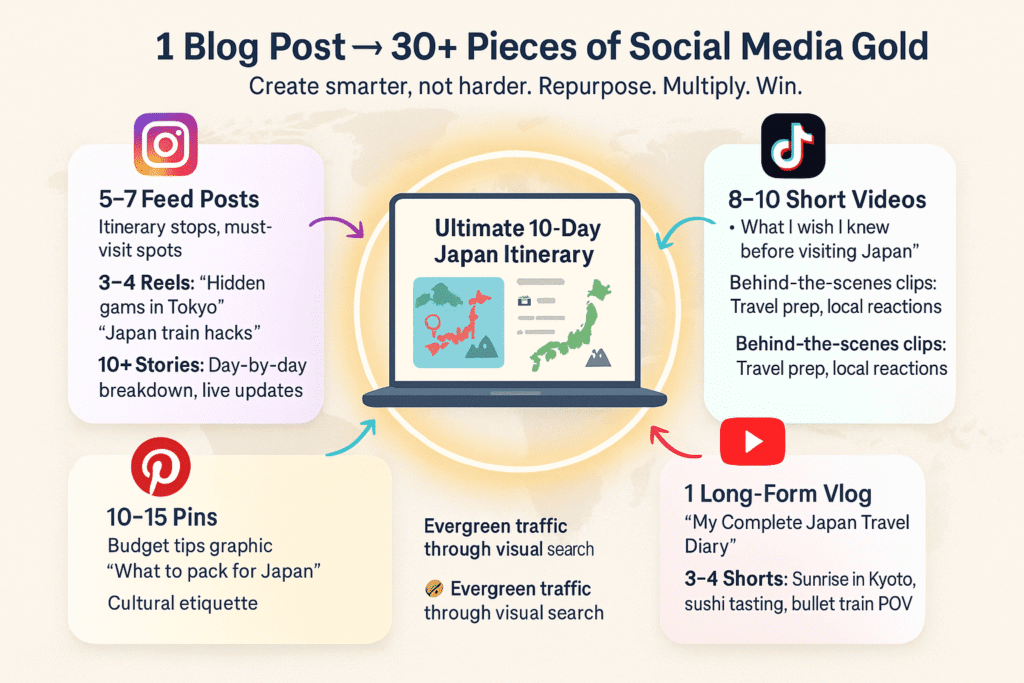
Begin with hero content, typically a long-form travel blog post or destination guide. From that, apply a content multiplication system to generate:
- Instagram: 5–7 feed posts, 10+ story content highlights, 3–4 Instagram Reels with quick tips
- TikTok: 8–10 TikTok videos, including behind-the-scenes content and snackable advice
- Pinterest: 10–15 pins with budget tips, itineraries, cultural insights, and visual content (photography)
- YouTube: One long-form video plus 3–4 YouTube Shorts showcasing highlights
Adaptation, Not Duplication
Each platform serves unique audience demographics. Instagram favors quick visual storytelling, TikTok thrives on entertaining short-form, Pinterest focuses on trip planning, and YouTube builds authority with depth.
The same Bali temple visit could be a serene Instagram carousel post, an energetic TikTok tip, and a detailed Pinterest guide, all boosting traffic generation.
Want to scale your content across all platforms?
Read our in-depth social media marketing guide and discover step-by-step strategies to build a strong social media presence.
AI Tools Travel Bloggers Can Use Right Now
Artificial intelligence isn’t replacing travel bloggers; it’s making the smart ones exponentially more productive. Here are the AI tools that are useful for travel blogs and content creators.
Content Creation AI Tools
ChatGPT for Caption Writing
Input your photo and details, then ask ChatGPT to draft captions. Great for visual aesthetics and captions, question prompts, and CTAs that drive audience engagement.
Copy.ai for Headlines
Perfect for blog titles or video hooks. Copy.ai produces platform-tailored headlines that strengthen platform-specific strategies and boost traffic generation.
Lumen5 for Video Creation
Turn travel blogs into video content automatically. Upload your blog post and Lumen5 builds clips with stock footage, audio, and overlays, supporting short-form videos and long-form storytelling.
Visual Content AI
Canva’s Magic Design
Input your content topic, and Canva’s AI suggests layouts for posts, story content, and Pinterest pins. It functions as a design tool (Canva) on autopilot, supporting a platform-native content approach for faster content creation.
Pictory for Video Editing
Convert written posts into professional video content without advanced skills. Especially useful for educational travel content, tutorials, and destination explainers. This tool also supports short-form videos for Reels, TikToks, or YouTube Shorts, giving travel bloggers scalable content repurposing options.
AI Tool Comparison Table
| Tool | Best For | Free Tier | Paid Plans | Time Saved Weekly |
| ChatGPT | Caption writing, idea generation | Limited | $20/month | 5–8 hours |
| Copy.ai | Headlines, ad copy | 2,000 words | $49/month | 2–3 hours |
| Lumen5 | Blog-to-video conversion | 3 videos | $29/month | 4–6 hours |
| Canva AI | Social media graphics | Limited | $15/month | 3–4 hours |
| Pictory | Script-to-video | 3 videos | $23/month | 6–8 hours |
| RecurPost AI | Social media post generation, recycling | Limited (with scheduling) | $25/month | 4–7 hours |
Analytics & Growth Tracking For Travel Bloggers
Data doesn’t lie, but tracking the wrong social media metrics can mislead you. Many travel bloggers either ignore analytics tracking or get stuck on vanity stats like follower count, which don’t reflect business objectives or long-term social media success.
Metrics That Matter
Follower count is a vanity metric; it’s the least relevant for long-term growth. Instead, track engagement metrics that reveal genuine audience engagement and align with business objectives.
Engagement Quality Over Quantity
Save Rate:
How often users save your content. A high save rate shows authentic content with lasting value, not just entertainment.
Comment Sentiment
Ten thoughtful comments outweigh 100 emojis. They reveal genuine interest and potential authentic relationships with followers.
Story Completion Rate
On Instagram, track viewers from start to finish. Strong rates mean your story content keeps your target audience engaged throughout.
Click-Through Rate
Whether it’s link clicks to your travel blog, affiliate products, or website, CTR highlights traffic generation and real conversion opportunities.
Platform-Specific Success Indicators For Travel Blog
Each platform defines success differently, so your analytics tracking should adapt to measure the right social media metrics and align with your content strategy.
Instagram Success Metrics:
- Reach growth month-over-month
- Story-to-feed conversion (when story content drives feed engagement)
- Profile visits from posts
- Website clicks from bio, reflecting traffic generation
TikTok Success Metrics:
- Average watch time per short-form video
- Profile visits from TikTok videos
- Follower conversion rate (views into followers)
- Cross-platform traffic, moving viewers from TikTok to Instagram or your travel blog
Pinterest Success Metrics:
- Monthly impressions growth
- Click-through rate (CTR) to your travel blog
- Save-to-click ratio
- Seasonal performance, tied to audience demographics and planning behavior
Growth Hacks Based on Data
Top travel bloggers analyze performance data to spot trends and double down on winning tactics. These analytics tools’ insights reveal real opportunities for higher engagement metrics and social media success.
Content Timing Optimization
Post when your target audience is most active, not just when convenient. Use scheduling tools aligned with posting frequency and best times to post to maximize reach and engagement rates.
Hashtag Performance Analysis
Track which hashtags fuel traffic generation versus those that create vanity reach. Create hashtag sets by content type (travel tips, destination posts, behind-the-scenes content) and rotate them monthly. Keep hashtags driving profile visits and website clicks, and replace weak performers.
Content Format Testing
Test whether carousel posts, single images, or short-form videos resonate more. Use content repurposing tactics to reframe tips in different formats. Run A/B tests comparing saves, comments, and clicks. Let real data, not assumptions, shape your content strategy.
Interactive Case Study Builder Template
Instead of just reading about analytics, build systems for analytics tracking and measuring engagement metrics. This ensures growth strategies align with business objectives and long-term social media success.
Monthly Performance Review Framework
Content Performance Analysis:
- Top 5 performing posts by engagement rate and saves
- Top 5 posts by reach
- Top 5 posts by website clicks and traffic generation
- Bottom 5 underperformers to avoid
Audience Growth Analysis:
- New followers gained
- Follower loss (and potential reasons)
- Shifts in audience demographics
- Geographic audience changes
Business Impact Analysis:
- Website traffic from social media
- Email subscribers gained from social content
- Affiliate clicks and conversions
- Quality of brand partnership inquiries
Weekly Optimization Checklist
Spend 30 minutes weekly on performance reviews:
- Which posts exceeded average engagement rates and why?
- Which posts underperformed and what lessons were learned?
- What audience feedback can inspire next week’s content creation?
- Are you keeping your content mix balanced (educational, inspirational, behind-the-scenes content)?
This weekly review process supports quick adaptation, better content strategy, and sustained growth.
Real Case Studies: Successful Travel Bloggers Who Nailed It
Learning from top travel bloggers offers real proof of how smart content strategy and authentic storytelling drive success. These aren’t theories—they’re tested tactics showing how creators scale social media marketing for travel blogs, achieve audience engagement, and secure brand partnerships while building profitable brands.
Kirsten Alana: From General Photographer to Travel Content Powerhouse
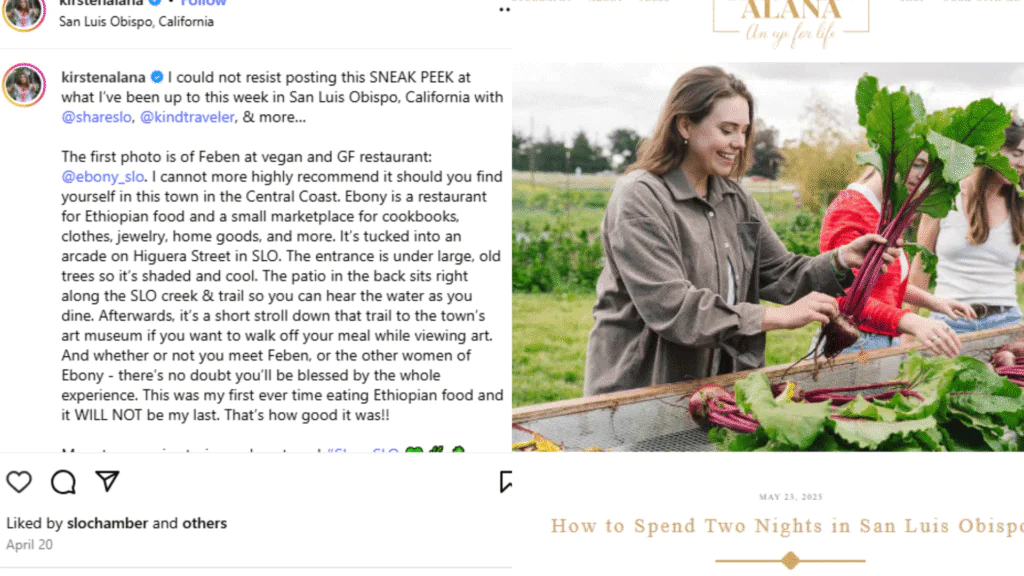
Successful travel blogs like @KirstenAlana stand out by blending professional photography with authentic storytelling and content strategy framed as “conscious storytelling.”
This positioning helped Kirsten transform her photography career into a thriving creator-led travel brand, scaling to 185K Instagram followers while landing brand partnerships with Elle, HuffPost, Mashable, Harper’s Bazaar, and Daily Mail.
The Foundation: Professional Skills Meet Strategic Positioning
Background & Transition
Kirsten’s career started with journalism training, then portrait photography, before shifting in 2010 to content creation in the travel space. She launched her travel blog, using professional photography skills plus authentic imagery to stand out. By aligning her work with industry trends and niche positioning, she differentiated herself in a crowded market of travel bloggers.
The “Conscious Storytelling” Differentiator
Instead of generic snapshots, Kirsten embraced authentic storytelling with a focus on culture and responsibility. Her content strategy positioned her as a “conscious storyteller,” aligning with sustainability-focused storytelling trends. This resonates with modern travelers who value responsible experiences and helped her stand apart from surface-level travel content.
Content Strategy: Quality Over Quantity
Professional Excellence as Baseline
Kirsten’s formal photography background set her apart with professional photography skills that deliver credibility and high-quality visuals. Her travel blog content reflects both artistry and expertise, making each destination more engaging.
Strategic Geographic Focus
Rather than covering every location, she developed niche authority in specific regions while mixing local Los Angeles stories with global adventures. This aligns with niche specialization practices that boost brand visibility in targeted markets.
Authentic Narrative Integration
Every post blends visuals with authentic content and storytelling, offering educational travel content that inspires and informs. This mix provides value beyond surface images, supporting stronger audience engagement.
Business Model: Multiple Revenue Streams
Premium Brand Partnerships
Kirsten’s roster spans global media outlets, showing how brand collaborations and influencer partnerships result from consistent delivery of authentic content that meets editorial standards.
Direct Client Services
She markets herself as a “travel photographer and conscious storyteller for hire,” creating income from custom services while supporting long-term brand relationships and social media income streams.
Sustainable Growth Model
Her business thrives on multiple streams: direct client work, brand partnerships, affiliate marketing, sponsored posts, and publication deals. This diversified model reflects best practices in social media marketing for travel blogs, reducing reliance on any single channel.
Performance Metrics & Market Position
Audience Growth
With 185K followers built over 10+ years, Kirsten’s steady follower growth surpasses Instagram’s average 0.77–1.2% monthly. This proves strong alignment with her target audience and long-term social media success.
Engagement Quality
Although exact engagement rates aren’t public, sustained brand partnership inquiries and collaborations with premium publishers show performance above the 1–3% norm. Her professional photography and authentic storytelling elevate trust and boost audience engagement.
Industry Recognition
Partnerships with global publications reinforce her credibility. This recognition strengthens her brand visibility and positions her as an authority in the travel industry.
Natasha Danielle: Solo Female Travel TikTok Success Story
Leading travel bloggers like @theworldpursuit show how niche clarity drives growth. Natasha built 660.8K TikTok followers and 28.2M likes by owning the solo female travel niche. Her content strategy blends safety, empowerment, and practical advice that resonates with modern travelers seeking independence.
The Strategy
Solo Female Travel Niche
Natasha carved out a strong position in solo female travel, mixing practical tips with authentic content and empowerment messaging that builds audience engagement.
Adventure-Focused Content
Her bio highlights active travel: “I travel, hike, snowboard, & sleep, that’s it.” This positions her for niche specialization as an adventure creator appealing to budget-conscious audiences, boosting brand visibility.
Practical Value
Her posts deliver destination-specific advice, like “3 Things to Know Before Going to Greece,” designed for saves, shares, and higher engagement metrics across short-form videos.
Platform Mastery
TikTok-First Approach
TikTok-First Approach: Natasha focused on TikTok videos, leveraging the platform’s algorithm to expand reach through trending hashtags and platform optimization.
Cross-Platform Presence
She maintains Instagram while making TikTok her growth engine, showcasing cross-platform promotion strategies.
Key Insight
Her success proves solo female travel thrives when authentic storytelling is paired with platform-specific strategies and actionable tips, empowering others while driving long-term social media success.
From Posting to Profiting: Monetization for Travel Creators
Publishing engaging travel blog content is only half the work; sustainable income requires smart monetization systems. Leading travel bloggers achieve this by combining social media marketing for travel blogs with diversified income streams.
This includes brand partnerships, affiliate marketing, digital products, and custom services supported by authentic relationships with audiences. These trusted connections deliver higher conversion rates and long-term business growth, compared to purely promotional posts.
Collaborations & Brand Outreach That Actually Works
Many travel bloggers approach brand partnerships the wrong way, waiting for offers instead of building relationships. Successful creators treat outreach as part of their social media marketing plan, cultivating authentic relationships with brands and positioning themselves as valuable partners.
Building Your Brand Partnership Portfolio
- Start with Local Businesses: Begin with nearby hotels, restaurants, or tours. These brand collaborations help showcase authentic content while proving your ability to drive traffic generation and audience engagement.
- Document Everything: Build case studies tracking engagement metrics, reach, website traffic, and feedback. Organized performance tracking sheets strengthen pitches for larger brands.
- Develop Rate Cards: Know your worth. Base rates on engagement rates, audience demographics, and content creation scope, not just follower count. This data-driven approach increases brand partnership inquiries and long-term business growth.
The Outreach Email That Gets Responses
Subject lines are critical for brand collaborations. Generic lines like “Collaboration Opportunity” get ignored, while targeted ones, “How [Your Brand] Could Reach 50K Travel Planners”, spark brand partnership inquiries.
Your outreach email should highlight:
- Audience demographics and key engagement metrics
- Results from similar influencer partnerships and social media campaigns
- Clear content creation timeline, deliverables, and posting frequency and timing
- A professional media kit with analytics tracking and recent performance data
Building Long-Term Brand Relationships
One-off sponsored posts provide short-term revenue, but brand ambassadorships create reliable income streams. Travel creators succeed by focusing on long-term brand relationships with partners that match their brand voice and content strategy.
The strongest brand partnerships feel natural because they align with authentic content and audience engagement. These authentic ties deliver better results for brands, boost engagement rates, and build higher trust with your target audience.
Affiliate Marketing for Travel Bloggers
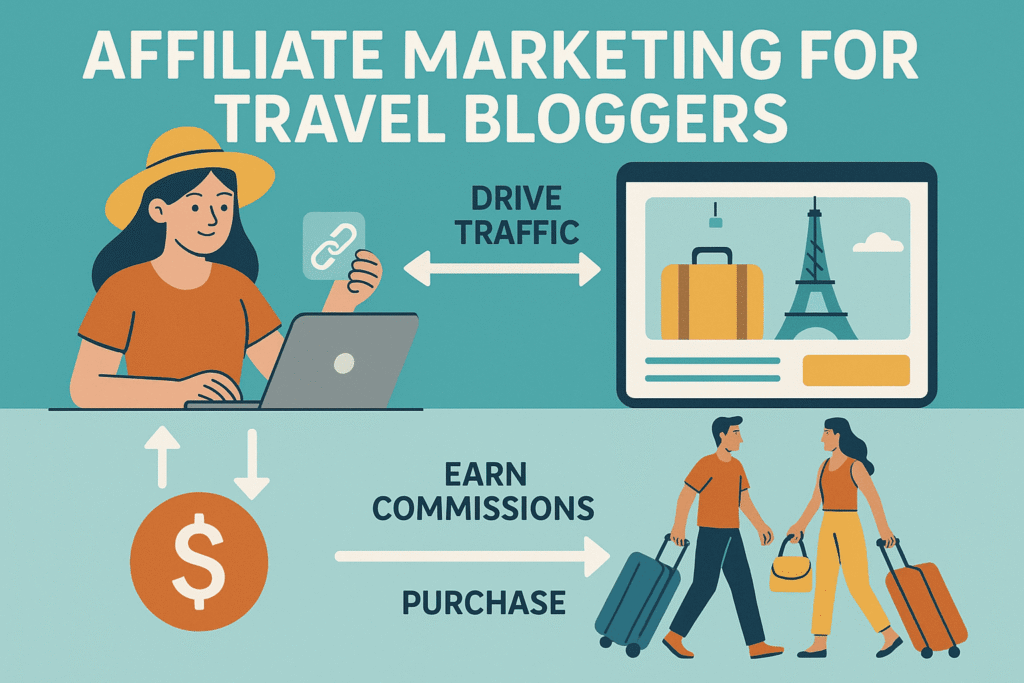
Affiliate marketing delivers passive income for travel bloggers, but success depends on smart product choices and authentic content promotion.
High-Converting Travel Affiliate Categories
- Travel Gear
Luggage, cameras, and accessories work well for content repurposing across blogs, short-form videos, or carousel posts.
- Accommodation Booking
Platforms like Booking.com and Airbnb offer strong potential for conversion rates and traffic generation, especially when featured in destination guides.
- Travel Insurance
High-ticket commissions combined with necessity make this a profitable niche, aligning with audience demographics who prioritize safety.
- Experience Bookings
Tours and activities on platforms like GetYourGuide or Viator convert effectively, especially in educational travel content and destination explainers.
Affiliate Travel Promotion Strategies That Convert
- Problem-Solution Content
Address specific travel challenges, then recommend affiliate products as solutions. “Protecting Electronics While Backpacking” naturally leads to affiliate links for protective gear.
- Honest Product Reviews
Detailed reviews (pros and cons) build trust, boosting engagement metrics and affiliate sales.
- Comparison Content
Posts like “Best Travel Cameras Under $500” allow multiple affiliate links while offering genuine value, strengthening audience engagement and business growth.
Lead Magnets, Travel Products & Digital Offers
Digital products and lead magnets create income streams that aren’t dependent on brand partnerships or affiliate commissions. They also establish you as an expert authority in travel planning.
Lead Magnets That Build Your Email List
- Destination-Specific Packing Lists
Attract subscribers with niche guides (e.g., Southeast Asia backpacking, European winter travel). Great for audience engagement and growing your email list.
- Budget Travelers Worksheets
Practical planning templates that appeal to cost-conscious audiences, driving lead generation and strengthening authentic relationships.
- Travel Planning Calendars
Month-by-month guides optimized for seasonal trends, helping your target audience plan trips effectively.
Digital Travel Products That Sell
- Comprehensive Travel Guides
Priced between $15–$40, these guides outperform traditional books and drive traffic generation from your travel blog content.
- Online Travel Planning Courses
Step-by-step systems that can be repurposed into short-form videos or blogs, offering scalable revenue streams.
- Custom Itinerary Services
Premium custom services priced from $200–$500+, valued by busy travelers seeking expert trip planning.
Pricing Strategies That Work In Travel Blogging
Start with affordable products ($15–$30) to build trust, then introduce premium bundles (guide + checklist + worksheet). Use performance data and analytics tracking to test pricing and align with audience demographics.
Test different price points using limited-time promotions to find your audience’s price sensitivity. Many travel bloggers undervalue their expertise and price products too low, leaving money on the table.
Travel Content That Scales: Workflow + Strategy
Scaling travel blog content requires consistency, smart workflows, and systems that support long-term business growth. The gap between hobbyists and top travel bloggers often comes down to efficiency in content creation, planning, and sustainable content strategy.
The Content Creation Assembly Line
Successful travel creators treat content batching as a workflow standard. They work like mini media companies with transparent processes, role definition, and platform-specific adaptation that maximizes output while protecting quality and brand consistency.
Batch Content Creation Process
- Planning Phase (Monthly)
Dedicate one day to content calendar structure. Review travel schedules, seasonal trends, and audience research to map posts and align with posting frequency and timing.
- Research Phase (Weekly)
Spend 2–3 hours reviewing industry trends, competitor moves, and audience demographics. These insights inform content strategy and improve algorithm optimization.
- Creation Phase (Bi-weekly)
Block 6–8 hours for batch content creation. Produce short-form videos (TikTok, Reels), blog posts, and visuals in bursts. This supports cross-platform promotion while maintaining creative energy.
- Editing Phase (Weekly)
Assign days for editing. Group tasks (videos on Tuesday, graphics on Wednesday) for efficiency. Use design tools (Canva) and video editing tools to boost output quality and protect brand consistency.
Content Documentation System For Travelling
- Shot Lists
Create detailed lists before trips, covering wide shots, details, and behind-the-scenes content for platforms like Instagram Stories or TikTok. This ensures authentic imagery and consistent visual storytelling.
- Content Bank Organization
Build a structured system for assets. Organize by destination, content type, and season for fast reuse. A strong archive supports content repurposing and content multiplication system workflows.
- Caption and Copy Database
Store proven captions, CTAs, and email subject lines in a searchable archive. This reinforces brand voice, speeds up content creation, and ensures consistent engagement across platforms.
90 Days to Growth: Challenge for Travel Creators
Many travel bloggers approach growth randomly, posting inconsistently without a clear direction. This 90-day challenge provides a proven roadmap for audience growth, consistent engagement, and stronger social media marketing for travel blogs.
Days 1-30: Foundation Building
Week 1: Audit and Optimize: Audit performance across platforms. Optimize social media profiles for clear brand visibility. Update content calendar structure and enable analytics tracking for key metrics.
Week 2: Content Systems: Establish a streamlined content creation workflow. Build templates for different content types (Reels, TikTok videos, travel blog content). Add scheduling tools and hashtag sets.
Week 3: Audience Research: Conduct audience research and competitor analysis. Define audience demographics, create personas, and align with business objectives.
Week 4: Content Creation Sprint: Batch 30 days of posts using content batching. Film short-form videos, write captions, design graphics, and plan cross-platform promotion. Add lead magnets to grow your email list.
Days 31-60: Engagement and Growth
Weeks 5–6: Community Building: Reply to comments within 2 hours during peak activity. Actively engage with creators in your specific niches. Join travel-related Facebook groups and contribute valuable insights to boost community-focused content. Start building authentic relationships with potential collaborators and influencer partnerships.
Weeks 7–8: Content Optimization: Review performance data from your first month. Identify top-performing formats (Reels, TikTok, carousel posts). Test posting frequency and timing to align with platform algorithms. Run A/B tests on captions, hashtags, and visual content styles to maximize engagement rates and reach metrics.
Days 61-90: Monetization and Scaling
Weeks 9–10: Revenue Generation: Launch your first lead magnet with an email sequence to build your email list. Pitch 5 potential brand partnerships weekly and test affiliate marketing offers. Create your first digital products or custom services to diversify income and support business growth.
Weeks 11–12: Systems Refinement: Refine content creation workflows and automate tasks with scheduling tools. Scale high-performing content formats such as short-form videos, carousel posts, or blog guides. Use analytics tools for performance tracking and plan the next 90-day phase with stronger platform-specific strategies.
Weekly Tracking Metrics
Growth Metrics:
- New followers across all platforms
- Email list growth
- Website traffic from social media
- Brand partnership inquiries
Engagement Metrics:
- Average engagement rate per platform
- Comments-to-likes ratio
- Story completion rates
- Save rates for educational content
Revenue Metrics:
- Affiliate commission generated
- Digital product sales
- Brand partnership income
- Email list monetization
2025 Trends: What’s Next for Travel Bloggers on Social
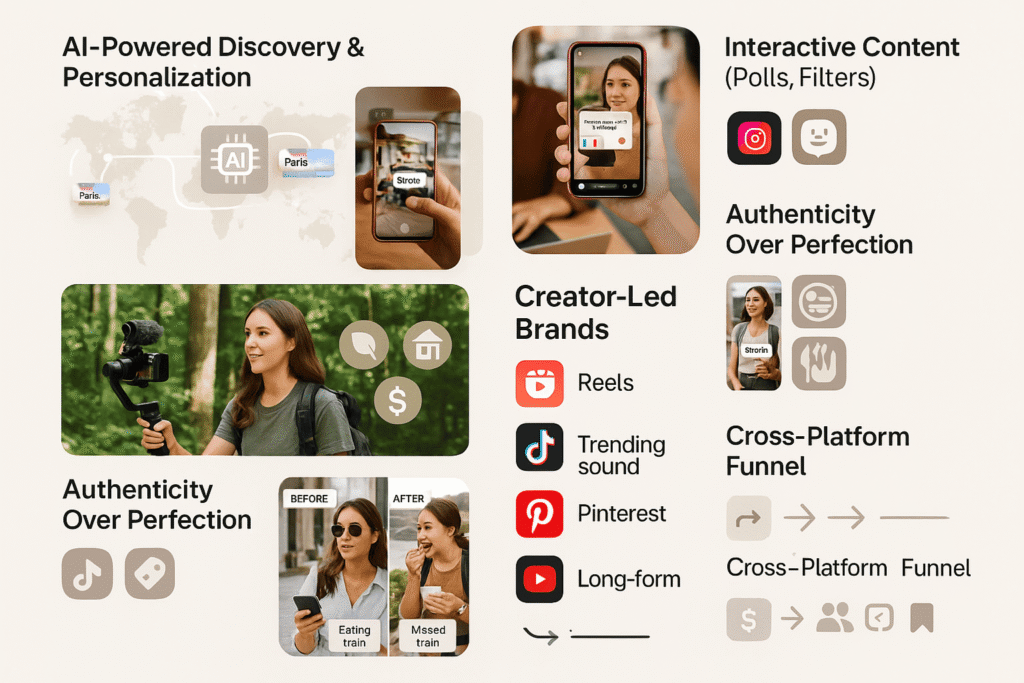
The travel content space in 2025 is competitive but filled with opportunity. Staying ahead of industry trends separates growth from stagnation. These shifts create new possibilities for travel bloggers who embrace a data-driven content strategy.
AI-Powered Discovery and Personalization
Artificial intelligence is reshaping how modern travelers find destinations. Platforms now use AI for AI-powered discovery, surfacing personalized recommendations based on preferences, search patterns, and audience demographics.
What This Means for Travel Creators
Instead of broad “Best of Europe” guides, creators are producing niche specialization content. Posts like “Solo Female Travel in Romania for Photography Enthusiasts” outperform generic lists by aligning with target audience interests and boosting engagement metrics.
- Interactive Content Integration
Social platforms in 2025 reward interactive content integration that pushes users beyond passive scrolling. Features like polls, quizzes, and AR filters simulate destination experiences. This type of interactive content fuels audience engagement, drives higher engagement rates, and supports community building around your travel blog content.
- Predictive Content Planning
AI tools now forecast seasonal trends, booking patterns, and audience demographics, predicting popular destinations 6–12 months ahead. Smart travel bloggers apply this data-driven method to shape content calendars, align with algorithm optimization, and produce educational travel content before demand peaks. This proactive planning strengthens traffic generation and long-term business growth.
Sustainability-Focused Storytelling
Sustainability is no longer optional in travel blog content. Younger modern travelers demand that creators integrate eco-conscious practices, overtourism awareness, and responsible travel messaging into their content strategy.
Sustainable Travel Content That Resonates
- Overtourism Solutions
Instead of promoting crowded spots, travel bloggers highlight alternative destinations. This supports authentic content and improves audience engagement while lowering environmental impact.
- Local Economic Impact
Posts that show how travel dollars help small businesses, local communities, and conservation initiatives foster authentic relationships with your target audience.
- Carbon Footprint Awareness
Including carbon offset data, slow travel, and transport alternatives in posts blends naturally into educational travel content, building brand visibility and long-term credibility.
- Authenticity Over Perfection
The polished Instagram aesthetic is fading. Today’s modern travelers crave authentic content that shows real experiences, from travel wins to mistakes. Travel bloggers who share behind-the-scenes content and unfiltered stories see stronger audience engagement, higher engagement rates, and deeper, authentic relationships with their target audience.
Creator-Led Travel Brands
Travel bloggers are evolving beyond content creation into full-scale travel companies. The most successful creators are launching their own travel products, services, and experiences.
The Creator-to-Entrepreneur Pipeline
- Group Travel Experiences
Travel creators are organizing and leading group trips, combining their expertise with direct monetization opportunities.
- Travel Planning Services
Creators are packaging their destination knowledge into consulting services, custom itinerary creation, and travel planning courses.
- Affiliate Program Creation
Some creators are launching their affiliate programs, allowing other creators to promote their products and services.
- Brand Partnerships Evolution
The creator-brand relationship is becoming more sophisticated. Instead of one-off sponsored posts, brands are seeking long-term partnerships that include product development, exclusive content series, and co-created experiences.
Multi-Platform Content Strategy
The most successful travel creators are developing platform-specific content strategies rather than simply cross-posting duplicate content everywhere.
Platform-Native Content Approach
- Instagram: Focusing on visual storytelling with a strong emphasis on Stories and Reels for real-time engagement.
- TikTok: Educational content that entertains, with emphasis on trending sounds and challenges adapted for travel.
- Pinterest: SEO-optimized pins designed for discovery during travel planning phases.
- YouTube: Long-form educational content that establishes expertise and authority in specific travel niches.
Cross-Platform Funnel Strategy
Brilliant creators use each platform as part of a larger funnel system. TikTok discovery leads to Instagram followers, which drive blog traffic, which converts to email subscribers, who eventually become customers.
Micro-Influencer Monetization
Brands are shifting budgets toward micro-influencers (10K-100K followers) who demonstrate higher engagement rates and more authentic audience relationships than mega-influencers.
What This Means for Growing Creators
- Quality Over Quantity: Engagement rate and audience authenticity matter more than follower count for monetization opportunities.
- Niche Specialization: Creators who specialize in specific travel niches (solo female travel, budget backpacking, luxury family travel) are more attractive to brands than generalist accounts.
- Long-Term Partnerships: Brands prefer ongoing relationships with creators who can demonstrate consistent audience engagement and authentic brand alignment.
Freebies & Downloads Hub For Travel Bloggers
Here’s your complete toolkit for implementing everything we’ve covered in this guide. These resources are designed to save you hours of planning and help you execute the strategies immediately.
Content Calendar Template
- Monthly Planning Template: Includes sections for seasonal trends, content themes, platform-specific posting schedules, and brand partnership tracking.
- Weekly Content Planner: Day-by-day planning grid with space for captions, hashtags, and cross-platform adaptation notes.
- Travel Content Shot List: A Comprehensive checklist covering all content types you should capture during trips, organized by platform requirements.
Download– Free Instagram content calendar to plan and schedule
Case Study Builder Worksheet
- Performance Tracking Sheet: Monthly and weekly metrics tracking for all platforms, including engagement rates, reach, website traffic, and monetization metrics.
- Content Analysis Framework: Template for analyzing your top and bottom-performing content to identify patterns and optimization opportunities.
- Growth Goal Setting: Quarterly goal-setting worksheet with specific, measurable targets for followers, engagement, and revenue.
Hook & Caption Vault
- 50 Proven Hook Templates: Tested opening lines for different content types (educational, inspirational, behind-the-scenes, promotional).
- Caption Formulas: Plug-and-play caption structures for different platforms and content goals.
- Call-to-Action Bank: Engagement-driving questions and prompts organized by platform and content type.
AI Tools Implementation Guide For Travel Bloggers
- Tool Setup Instructions: Step-by-step guides for implementing ChatGPT, Copy.ai, Canva AI, and other tools in your workflow.
- Prompt Templates: Proven prompts for generating captions, headlines, and content ideas using AI tools.
- Workflow Integration: How to incorporate AI tools into your existing content creation process without disrupting your brand voice.
90-Day Challenge Calendar
- Printable Calendar: Day-by-day action items for the complete 90-day growth challenge.
- Weekly Checklist: Specific tasks and milestones for each week of the challenge.
- Progress Tracking: Metrics to monitor and celebrate throughout your 90-day journey.
Final Thoughts: Your Beaten Path to Travel Content Success
We’ve covered strategies from platform-specific tactics to monetization to emerging industry trends. But information is useless without execution. The real winners in social media marketing for travel blogs are the ones who act on proven systems.
You don’t need to master everything immediately. Pick one platform, apply one content strategy, and commit for 90 days. Whether launching a new travel blog or scaling an existing one, consistent effort creates long-term business growth.
The travel content space is crowded but full of opportunity. Brands are investing more in brand partnerships, audiences demand authentic content and valuable insights, and modern ai tools make content creation and cross-platform promotion faster than ever. Today, a travel blog can evolve into a hub for storytelling, influence, and income.
Your perspective, experiences, and authentic storytelling are your strongest assets. No one else can deliver the same voice, which is why your originality is your true brand voice advantage.
The creators who thrive in 2025 and beyond will master fundamentals: consistent engagement, audience research, platform-specific strategies, and diversified monetization through affiliate marketing, custom services, and digital products. If you want a successful travel blog, the time to act, adapt, and grow is now.
Frequently Asked Questions
1. What’s a good budget for social media marketing?
It depends on your goals and scale. Many travel bloggers start with free tools (like Canva Free, CapCut, Buffer Free) and spend ₹1,500–₹5,000/month when they upgrade to premium tools like Canva Pro or scheduling platforms once traction begins.
2. How do I measure actual success, not just likes?
Go beyond vanity metrics: track saves, comments, story completion rates, click-throughs to your blog, and affiliate income. These show real engagement and ROI.
3. Can I legally reuse other people’s travel images or videos?
No, always respect copyright. Use your own visuals or royalty‑free options from Unsplash or Canva. Better yet, create unique content to protect your brand and avoid legal trouble.
4. How often should I repurpose a travel post across platforms?
Aim for 1–2 repurposings per platform from one blog post: e.g., 3 Reels + 5 Pins + 1 YouTube Short + 2 TikToks. Adapt each to the platform style, don’t just copy and paste.
5. Is influencer marketing worth trying as a travel blogger?
Yes, when done authentically. Travel influencers often earn via brand collabs and affiliate links. Start small: pitch local tourism offices or gear brands once you have consistent engagement.
6. How do I know which hashtags drive real traffic?
Run hashtag sets by content type (e.g., budget tips, cultural posts). Track which sets yield more profile visits, website clicks, and saves, then refine monthly.
7. Do I need to post every day?
No, consistency and strategy matter more than frequency. Use a content calendar: theme each month, rotate weekly topics, and post platform-specific content a few times per week.

Fenil Patel makes complex topics simple and useful for readers who want clarity, value, and actionable takeaways. As an SEO content writer with 4+ years of experience, he creates blogs and website content that answer real questions, solve problems, and guide readers toward informed decisions. Whether it’s healthcare, fashion, or SaaS, Fenil’s writing is designed to give you practical insights while ensuring the information you read is trustworthy, engaging, and easy to apply.

